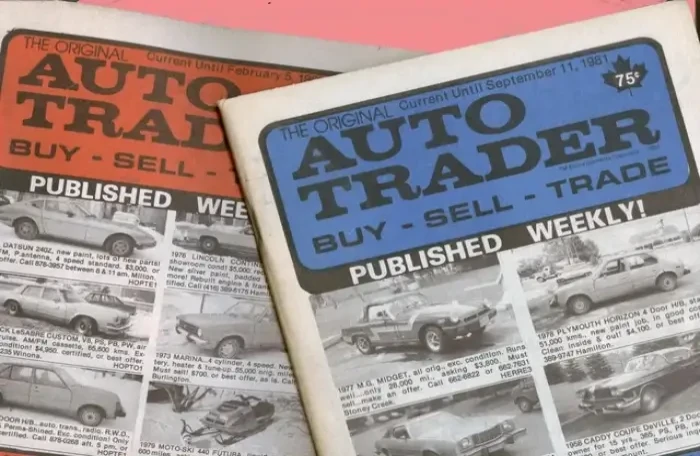Your Complete AutoTrader Used Car Buying Guide Made Simple

Lila Claybourne
Aug 30, 2024

Summary
Introduction to AutoTrader’s platform and the benefits of buying a used car online.
Step-by-step instructions from defining your needs to completing the purchase.
Expanded sections on researching, negotiating, inspection checklists, and financing.
Detailed FAQs addressing common concerns and advice for avoiding pitfalls.
Mention of AmeriFreight for reliable car shipping services.
The Convenience and Confidence of Buying a Used Car Online
Buying a used car online has never been easier, thanks to platforms like AutoTrader. With thousands of listings and a variety of tools at your disposal, you can find the perfect vehicle from the comfort of your home. However, this convenience also requires a strategic approach to ensure you make a sound investment. This guide will take you through each step, offering practical tips and examples to help you make an informed purchase.
Why Buy a Used Car on AutoTrader?
AutoTrader is a leading platform for used car purchases, offering:
Extensive Listings: Thousands of cars from both private sellers and dealerships.
Comprehensive Details: High-quality photos, detailed descriptions, and vehicle history reports.
User-Friendly Experience: Easy-to-use filters and tools to find exactly what you’re looking for.
Trust and Security: Established consumer protections and a reputation for reliability.
Real-World Example: Imagine you’re searching for a 2018 Honda Accord with less than 50,000 miles. AutoTrader’s filters allow you to narrow down your search to exactly these parameters, saving you time and helping you focus on the best options available.
Step 1: Define Your Needs and Budget
Before diving into the vast inventory on AutoTrader, it’s crucial to establish clear criteria:
Identify Your Needs: Consider factors like car type (sedan, SUV, etc.), necessary features (e.g. fuel efficiency, safety), and acceptable mileage.
Example: If you have a family, you might prioritize safety features and ample cargo space, while someone commuting long distances might focus on fuel efficiency.Set Your Budget: Consider not only the purchase price but also additional costs like insurance, maintenance, and registration. Decide whether you’ll pay in cash or finance the purchase.
Tip: Use online calculators to estimate monthly payments if financing. Set a firm maximum based on what you can comfortably afford, keeping in mind other financial commitments.
Why This Matters: A clear understanding of your needs and budget helps streamline your search, preventing costly mistakes and ensuring you find a vehicle that fits both your lifestyle and financial situation.
Step 2: Research and Narrow Down Your Options
Research is key to finding the right car. Here’s how to make the most of AutoTrader’s tools:
Use AutoTrader’s Filters Effectively:
Price Range: Set a maximum price slightly above your budget to account for negotiations.
Mileage: Consider the average annual mileage (about 12,000 miles per year) to judge how much wear the car has endured.
Vehicle Condition: Filter by “Certified Pre-Owned” if you want a car that comes with a dealership-backed warranty.
Example: Suppose you’re looking for a 2017 Toyota Camry with under 60,000 miles. Start by setting your price range slightly above what you’re willing to pay, say $20,000, to see what’s available. Narrow it down further by specifying your desired mileage and selecting the “Accident-Free” option.
Evaluate Listings Carefully:
Photos: Look for clear, detailed images from multiple angles. Beware of listings with only a few or low-quality photos.
Descriptions: Read through the description for mentions of recent maintenance or any known issues. Listings that mention a clean title, regular maintenance, or recent repairs are often more trustworthy.
Check Vehicle History Reports:
Accident History: Prior accidents can affect a car’s long-term reliability and resale value.
Ownership History: Multiple owners or frequent sales can be red flags.
Service Records: Regular maintenance is a good indicator of a well-kept vehicle.
Tools to Use: Access Carfax or AutoCheck reports directly from the listing to verify the car’s history. These reports often include estimated market values, helping you gauge whether the asking price is fair.
Why This Matters: Using these tools effectively helps you avoid cars with hidden problems and ensures that you’re getting a fair deal. Thorough research is your best defense against buyer’s remorse.
Step 3: Contact the Seller
Engaging with the seller is a critical step in the buying process. Here’s how to do it right:
Initial Contact:
Be polite and professional. Ask if the car is still available and express your interest. Mention specific aspects of the car that caught your attention.
Example Message: “Hi, I’m interested in your 2017 Honda CR-V listed on AutoTrader. It looks like it’s in great condition, and I appreciate the detailed description. Is it still available?”
Ask Detailed Questions:
Why are you selling the car? This can give insight into potential issues or just life changes for the seller.
Has the car been involved in any accidents? Even minor accidents can affect a car’s value.
What is the current condition of the car? Ask about any known mechanical issues, the condition of the tires, and when the last service was performed.
Red Flags: If the seller is evasive or provides inconsistent information, proceed with caution.
Why This Matters: Effective communication can reveal important details about the car and the seller’s reliability. This step is crucial for ensuring you’re making a sound purchase.
Step 4: Arrange for an Inspection and Test Drive
Seeing the car in person and having it inspected is non-negotiable.
Checklist for Test Drive:
Engine Performance: Listen for unusual noises during startup and acceleration.
Brakes: Test the brakes at various speeds to ensure they respond promptly and don’t make noise.
Steering and Suspension: The car should handle smoothly without pulling to one side.
Interior Features: Check the functionality of air conditioning, radio, lights, and other electronics.
Example: During the test drive, pay attention to how the car drives on both city streets and highways. Make note of any unusual sounds or vibrations, as these could indicate underlying issues.
Get a Pre-Purchase Inspection:
Hire a trusted mechanic to perform a thorough inspection. They’ll check for signs of previous damage, worn-out parts, and potential future issues.
Checklist for Inspection:
Tire Wear: Uneven wear can indicate alignment issues.
Brake Pads and Rotors: Worn pads or damaged rotors can lead to costly repairs.
Under the Hood: The mechanic should check for fluid leaks, corrosion, and the condition of the belts.
Under the Car: Look for rust or damage to the frame and exhaust system.
Why This Matters: A comprehensive inspection and test drive can prevent you from buying a car that may require expensive repairs soon after purchase. It’s an investment in peace of mind.
Step 5: Negotiating the Price
Negotiation is where your research pays off.
Step-by-Step Negotiation Strategy:
Research Market Value: Use Kelley Blue Book or NADA Guides to determine the car’s fair market value based on its condition, mileage, and location.
Start with a Reasonable Offer: Begin slightly below the market value, giving you room to negotiate.
Highlight Findings: Use the vehicle’s history report or inspection findings as leverage. If the car needs new tires or has minor cosmetic issues, mention these as reasons for a lower price.
Be Prepared to Walk Away: If the seller isn’t willing to negotiate to a fair price, don’t be afraid to leave the deal.
Example: Suppose the car is listed at $15,000, but your research shows its market value is closer to $13,500. Start with an offer of $13,000, citing any necessary repairs or maintenance as reasons for the lower price.
Why This Matters: A structured approach to negotiation helps ensure you don’t overpay for the car. Remember, the goal is to reach a fair price for both you and the seller.
Step 6: Secure Financing (If Needed)
If you’re not paying cash, you’ll need to explore financing options.
Ideal Loan Term Lengths:
Shorter Terms (36-48 months): Higher monthly payments but less interest over time.
Longer Terms (60-72 months): Lower monthly payments but higher overall interest costs.
Expert Advice: Avoid financing terms longer than 60 months if possible, as they can lead to paying more in interest and facing negative equity (owing more than the car is worth).
Getting Pre-Approved:
Pre-approval gives you a clearer budget and strengthens your negotiating position with the seller.
Compare interest rates from banks, credit unions, and dealerships to find the best deal.
Understanding the Terms:
Interest Rate: The lower, the better. Even a small difference in percentage points can save you hundreds over the life of the loan.
Total Cost: Look at the total amount you’ll pay by the end of the term, not just the monthly payment.
Why This Matters: Financing decisions can significantly impact the overall cost of your car. Being informed about loan terms and interest rates ensures you don’t end up paying more than necessary.
Step 7: Complete the Paperwork
Finalizing the sale involves several important steps:
Essential Paperwork:
Title Transfer: The title proves ownership. Make sure it’s signed over to you correctly.
Bill of Sale: This document records the transaction, including the sale price and any agreed-upon conditions.
Odometer Disclosure Statement: Federal law requires this for cars less than 10 years old to confirm the mileage is accurate.
State-Specific Requirements: Check with your local DMV for any additional paperwork or fees required in your state.
Avoiding Scams:
Be wary of sellers who rush the transaction or ask for payment via unconventional methods like wire transfers. Stick to secure payment methods, such as cashier’s checks or an escrow service.
Why This Matters: Properly completing the paperwork is crucial for legally transferring ownership and protecting yourself from fraud. It ensures all aspects of the sale are documented and legitimate.
Step 8: Arrange for Insurance and Registration
Before hitting the road, you need to ensure your new car is both insured and registered:
Choosing the Right Insurance:
Coverage Levels: Liability insurance is mandatory, but consider comprehensive and collision coverage, especially for newer vehicles.
Shopping Around: Get quotes from multiple providers to find the best deal. Online comparison tools can make this process easier.
Registering the Vehicle:
Visit your local DMV with the necessary documents, including the signed title, bill of sale, and proof of insurance. Some states allow online registration, streamlining the process.
Timely Registration:
Each state has specific deadlines for registering a newly purchased vehicle. Failing to register on time can result in penalties and fines.
Why This Matters: Insurance and registration are legal requirements. Properly handling these ensures you’re fully compliant with state laws and protected in case of accidents or theft.
Step 9: Finalize the Purchase and Take Delivery
With everything in place, you’re ready to complete the transaction and take possession of your new car.
Final Payment:
Ensure all conditions are met before making the final payment. If paying by cashier’s check, bring it with you to the final meeting with the seller.
Final Inspection:
Before driving away, do one last inspection to confirm everything is as agreed. This is your last opportunity to address any issues with the seller.
Set Up the Car:
If transferring license plates, do so immediately. Set up your in-car systems, such as Bluetooth, GPS, and other electronics, to your preferences.
Why This Matters: Completing the final steps with care ensures a smooth transition and allows you to start enjoying your new car without any hitches.
FAQs About Buying a Used Car on AutoTrader
1. How can I verify the car’s history?
Use Carfax or AutoCheck to obtain a detailed vehicle history report. These reports provide information on past accidents, title issues, and maintenance records, helping you make an informed decision.
2. What if the deal falls through?
If the deal doesn’t work out, don’t be discouraged. It’s better to pass on a car than to rush into a bad deal. Use what you’ve learned to refine your search criteria and keep looking.
3. Should I buy from a private seller or a dealership?
Private sellers often have lower prices, but dealerships may offer warranties and more robust consumer protections. Decide based on your comfort level and the specific car you’re interested in.
4. Can I return a used car if I’m not satisfied?
Return policies vary. Private sales are usually final, while some dealerships might offer a return window. Always clarify the return policy before making a purchase.
5. How can I ensure the car I buy is a good deal?
Research the car’s market value, get a pre-purchase inspection, and use the findings to negotiate a fair price. Tools like Kelley Blue Book can provide a reliable benchmark for the car’s value.
6. What are the risks of financing a used car?
Financing a used car over a long term can lead to negative equity, where you owe more than the car is worth. It’s important to balance the monthly payment with the overall cost, aiming for shorter loan terms when possible.
Conclusion
Buying a used car on AutoTrader can be a rewarding experience, provided you follow a careful and informed approach. From defining your needs to negotiating a fair price and completing the necessary paperwork, each step is crucial to ensuring you end up with a vehicle that meets your expectations and fits your budget.
If you're purchasing a car from an out-of-state seller, consider using AmeriFreight for reliable and affordable car shipping services. Get an instant quote here.
Additional Resources
AutoTrader Guides: For more tips on buying used cars, visit AutoTrader’s official guides.
Kelley Blue Book: Research car values and get pricing advice at KBB.com.
Carfax: Obtain vehicle history reports to ensure a sound purchase at Carfax.com.
Related Posts
















